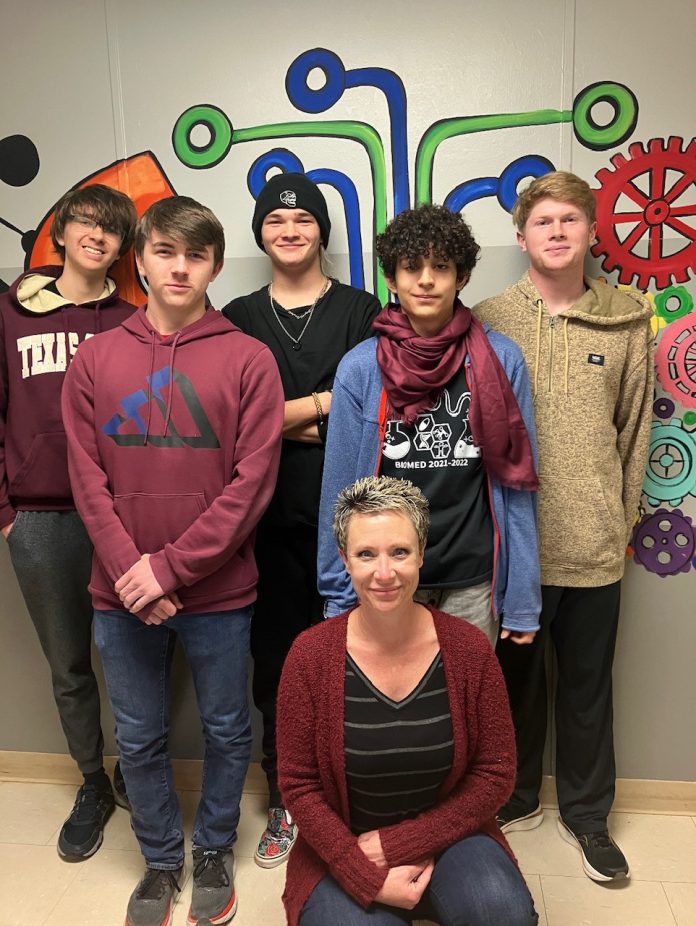Ector County ISD announced Friday that a team of five students from the STEM Academy campus will be sending an experiment to the International Space Station in the summer of 2023 as part of Mission 17 of the Student Spaceflight Experiments Program.
SSEP is an international program that engages students in designing experiments that will be carried out in microgravity by astronauts on the ISS. This will be the fourth experiment from ECISD flown to the ISS as part of the SSEP program.
The winning student team, coached by their teacher Karey Grametbaur, created an experiment to test whether a specific fungus, Pestalotiopsis microspora, would survive and reproduce in space with the goal of the fungus breaking down waste plastic into biodegradable components. The biodegradable byproduct of this experiment could then be used by astronauts to grow plants in.
The team members from STEM Academy are: Evan Hernandez (10th grade); Bryan Nash (10th grade); Georgi Shoumaroff (11th grade); Evan Boyer (10th grade); and Kagan Holder (10th grade).
These students will be continuing work on their experiment this spring, with mentoring from their teacher and two faculty members from the University of Texas Permian Basin Biology department, before it rockets to space this summer. Participation in SSEP provides a pathway not only to real-world STEM (science, technology, engineering, and math) and real spaceflight, but also to pursuing STEM subjects in college by building relationships with university-level mentors.
The experiment will spend 4 to 6 weeks aboard the ISS where astronauts will follow instructions provided by the student team to carry out the experiment. The experiment will then be returned to Earth and the students will compare the results between the sample that went to space with an identical sample that stayed on Earth.
Two other teams from ECISD were finalists in the flight experiment competition:
George H.W. Bush New Tech Odessa (coached by teachers Lornalyn De Leon and Maria Lopez): Eva Brower (10th grade); Nathalaine Denise De Leon (11th grade); Mikail Karais (10th grade); Adrian Rodriguez (10th grade); and Beverly Lanae Vanessa Woods (11th grade).
Hays STEAM Academy (coached by teacher Erika Pocaterra): Horacio Hernandez Frias (5th grade); Cristian Eduardo Lopez (5th grade); Caleb Daniel Orozco (5th grade); Harper Pierce-DeShazo (5th grade).
Another exciting component of SSEP Mission 17 is the Mission Patch Art and Design Competition, which will kick off later this month. This competition carries on the tradition of the mission patch that has been part of spaceflight since the 1960s. Students in grades K-12 will have the opportunity to design a 3.5 by 3.5-inch piece of art commemorating ECISD’s SSEP Mission 17 experience, and one winning patch from grades K-5 and one patch from grades 6-12 will be selected by ECISD staff to accompany the STEM Academy team’s experiment to the ISS. The two winning mission patches will spend 4-6 weeks on the ISS and then be returned to the students embossed as “flown in space.”
ECISD would like to thank HEB, Chevron, the Education Foundation of Odessa, and Kepler Aerospace, whose support makes ECISD’s participation in SSEP possible, a news release said.
The Student Spaceflight Experiments Program is a program of the National Center for Earth and Space Science Education (NCESSE) in the U.S. and the Arthur C. Clarke Institute for Space Education internationally. It is enabled through a strategic partnership with Nanoracks, LLC, which is working with NASA under a Space Act Agreement as part of the utilization of the International Space Station as a National Laboratory.




